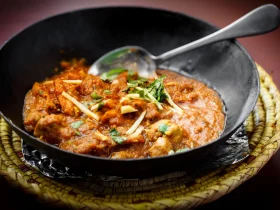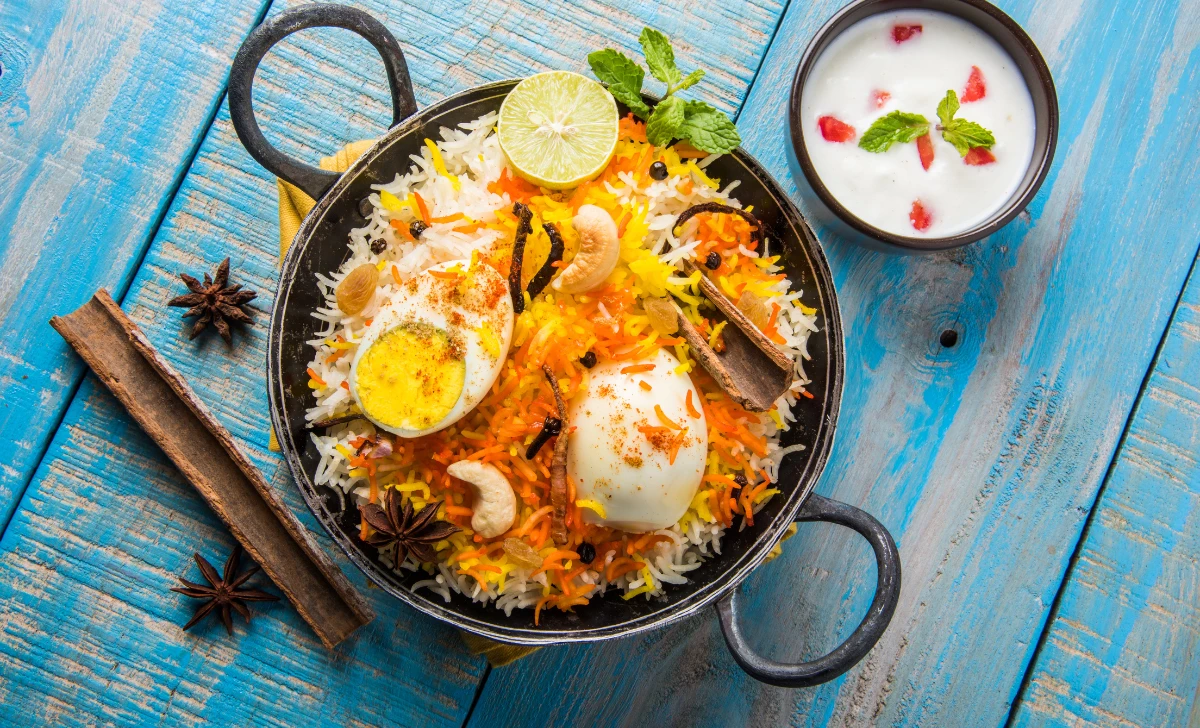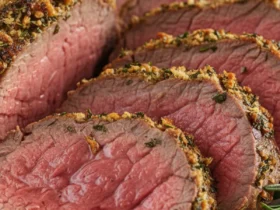Egg biryani, with its fragrant aroma and tantalizing blend of spices, is a dish that transcends cultural boundaries. Whether you’re a culinary enthusiast or simply seeking a new and exciting recipe, egg biryani is a must-try. This article will take you on a journey through the process of crafting this mouthwatering dish, from the marination of eggs to the final assembly of flavors. So, put on your apron and let’s embark on this flavorful adventure together!
[ez-toc]
History
If the aromatic tendrils of egg biryani could speak, they would tell tales of a rich and diverse history that spans centuries and cultures. This beloved dish carries within it a legacy that’s as fascinating as its flavors are enchanting.
Roots in Royal Kitchens
The story of biryani traces back to the opulent kitchens of ancient India. It was in the Mughal courts that the first chapters of this culinary journey were written. The Mughal emperors, renowned for their refined tastes, sought to create a dish that blended the flavors of their Central Asian heritage with the richness of Indian spices.
A Symphony of Influences
Egg biryani, like its counterparts, absorbed influences from various regions. The Persian pilaf, with its saffron-infused rice and aromatic meats, served as the initial inspiration. As the Mughals ruled over India, they incorporated local ingredients and techniques, giving rise to the biryani we know today.
From Royal Courts to Common Tables
Originally a dish reserved for royalty and special occasions, biryani eventually found its way to the common folk. The democratization of this culinary masterpiece led to regional variations and adaptations, each bearing the distinct imprint of local ingredients and cooking styles.
The Voyage Across Borders
The historical journey of egg biryani did not halt at India’s borders. As maritime trade routes connected nations, the dish traveled to the Middle East, Southeast Asia, and beyond. Each destination infused its own ingredients and traditions into the recipe, resulting in an array of global biryanis.
Symbol of Unity
Egg biryani, in all its variations, has earned a place as a symbol of unity and celebration. It is the dish that brings families together during festivals, binds friends over hearty meals, and transcends linguistic and cultural barriers.
Modern Innovations
In the modern era, egg biryani continues to evolve. Chefs and home cooks alike experiment with fusion, incorporating diverse ingredients and techniques. The advent of technology, like the Instant Pot, has further transformed the cooking process, making biryani accessible to even the busiest of individuals.
Preserving Tradition, Embracing Change
As we savor the flavors of egg biryani today, we pay homage to the generations that meticulously crafted and refined this culinary masterpiece. Each grain of rice, every spice-infused egg, tells a story of innovation and tradition, a tale that resonates across time and space.
So, the next time you indulge in a plate of fragrant egg biryani, remember that you’re not just tasting a dish—you’re tasting history.
Time
| Step | Time Required |
|---|---|
| Marinating the Eggs | 15 minutes |
| Sautéing the Aromatics | 10 minutes |
| Infusing with Spices | 5 minutes |
| Adding the Rice and Eggs | 15 minutes |
| Balancing the Spices | 5 minutes |
| Layering the Biryani | 10 minutes |
| Adding Vegetables or Paneer | 10 minutes |
| Garnishing and Adding Accompaniments | 5 minutes |
| Total Cooking and Preparation Time | 75 minutes (approx) |
Please note that these times are approximate and can vary based on individual cooking skills and kitchen setup.
Ingredients
| Ingredients | Quantity |
|---|---|
| Fresh eggs | 4 |
| Basmati rice | 1 cup |
| Onions | 2 medium |
| Tomatoes | 1 medium |
| Ginger and garlic | 1 tablespoon each |
| Yogurt | ¼ cup |
| Biryani masala | 1 tablespoon |
| Saffron strands | A pinch |
| Ghee | 2 tablespoons |
| Whole spices (cinnamon, cardamom, cloves) | 2 each |
| Fresh coriander and mint leaves | A handful each |
| Cashews and raisins | 2 tablespoons each |
Please adjust the quantities based on your preferences and the desired level of flavor and richness.
Directions
Marinating the Eggs
- Boil and Peel the Eggs: Start by boiling the eggs until they are hard-boiled. Once done, peel them and make small slits with a knife, allowing the marinade to penetrate.
- Prepare the Marinade: In a bowl, mix yogurt, biryani masala, and a pinch of saffron strands. Coat the eggs with this marinade, ensuring they are well-covered. Let them marinate for at least 15 minutes to infuse the flavors.
Sautéing the Aromatics
- Sizzle the Spices: In a heavy-bottomed pan, heat ghee over medium heat. Add the whole spices—cinnamon, cardamom, and cloves—to the pan, letting them release their aroma.
- Golden Onions: Add finely sliced onions and sauté until they turn golden-brown. The sweet aroma of caramelized onions will fill the air.
Infusing with Spices
- Ginger and Garlic Magic: Incorporate minced ginger and garlic, sautéing for a minute until their fragrances mingle with the onions.
- Tomato Tanginess: Add finely chopped tomatoes and cook until they soften, forming a flavorful base for your biryani.
Adding the Rice and Eggs
- Rice Ritual: Wash and soak Basmati rice for 30 minutes. Drain the water and add the rice to the pan, gently mixing it with the sautéed spices and aromatics.
- Layering Symphony: Gently place the marinated eggs over the rice, creating an alternating pattern. Ensure each egg is nestled comfortably in a bed of rice.
Balancing the Spices
- Final Spice Infusion: Sprinkle a bit more biryani masala over the rice and eggs. This final touch ensures that every bite is infused with the essence of spices.
Layering the Biryani
- Herbaceous Elegance: Add a layer of fresh coriander and mint leaves over the eggs. Their vibrant colors and aromatic freshness will permeate the dish.
Customizing with Vegetables or Paneer
- Veggie Delight: If desired, add a layer of cooked vegetables like carrots, beans, and peas, enhancing the nutritional value and adding a delightful crunch.
- Paneer Twist: Alternatively, swap eggs for paneer cubes that have been marinated similarly. This variation brings a rich, creamy dimension to the dish.
Garnishing and Adding Accompaniments
- Crunchy Goodness: Garnish with crispy golden-brown fried onions, cashews, and raisins. These toppings add a textural contrast to the biryani.
- Cooling Companion: Serve your egg biryani with a side of cucumber raita. Its refreshing tanginess balances the spices and cools the palate.
Final Assembly and Serving
- Sealing the Flavors: Cover the pan with a tight-fitting lid or foil, ensuring that the steam doesn’t escape. Allow the biryani to steam on low heat for about 15 minutes, letting the flavors mingle and intensify.
- Plate and Enjoy: Carefully unveil the biryani, letting the aromatic steam escape. Gently fluff the rice with a fork, ensuring that the layers remain intact. Serve your egg biryani hot, savoring each bite that captures the essence of this remarkable dish.
Follow these steps, and you’ll have a plate of Egg Biryani that’s a testament to your culinary prowess. Enjoy the symphony of flavors and aromas as they dance on your taste buds!
Equipment Required
Nutrition Information
| Nutrient | Amount per Serving |
|---|---|
| Serving Size | 1 plate (approx. 1/2 cup) |
| Calories | 350 |
| Total Fat | 12g |
| Saturated Fat | 4g |
| Cholesterol | 200mg |
| Sodium | 450mg |
| Total Carbohydrates | 45g |
| Dietary Fiber | 2g |
| Sugars | 3g |
| Protein | 14g |
| Vitamin D | 10% DV |
| Calcium | 8% DV |
| Iron | 15% DV |
| Potassium | 10% DV |
Please note that these values are approximate and can vary based on portion sizes and specific ingredients used. Always consult with a registered dietitian or nutritionist for accurate nutritional information tailored to your dietary needs.
Tips
- Perfectly Cooked Eggs: To achieve eggs with a creamy yolk and tender whites, boil them for about 10 minutes and then shock them in ice water. This prevents overcooking and results in eggs that are easy to peel.
- Fragrant Basmati Rice: For fluffy rice grains that don’t stick together, rinse the Basmati rice thoroughly under cold water until the water runs clear. Soaking the rice for 30 minutes before cooking also helps in achieving the desired texture.
- Layer with Care: While layering the biryani, ensure even distribution of eggs and rice. A gentle hand ensures that each forkful offers a perfect balance of flavors.
- Gentle Heat: When simmering the biryani, use the lowest heat setting possible. This gentle cooking process allows the flavors to meld and develop without scorching the bottom.
- Sealing the Pot: To prevent steam from escaping while the biryani cooks, you can use a dough seal around the lid. This technique locks in the moisture, infusing the rice with the aromatic goodness.
Pros & Cons
| Pros | Cons |
|---|---|
| ✔️ Bursting with Aromatic Flavors | ❌ Requires Multiple Steps |
| ✔️ Balanced Blend of Spices | ❌ Time-Intensive Preparation |
| ✔️ Versatile with Customization | ❌ High in Cholesterol |
| ✔️ Rich in Protein | ❌ May Be Spicy for Some Palates |
| ✔️ Comforting and Satisfying | ❌ Requires Special Ingredients |
Conclusion
As we wrap up this flavorful journey through the world of Egg Biryani, we hope you’re left with a sense of anticipation and culinary excitement. Egg Biryani, with its intricate layers of spices, aromatic rice, and succulent eggs, is more than just a dish; it’s a sensory experience that captures the essence of centuries-old traditions and modern gastronomic creativity.
With each bite of Egg Biryani, you’ll savor the harmonious dance of flavors and textures—tender eggs, fragrant rice, and a symphony of spices that awaken your taste buds. Whether you’re a novice cook seeking a new challenge or an experienced home chef looking to expand your repertoire, this recipe offers the perfect blend of familiarity and innovation.
So, don your apron, gather your ingredients, and let the fragrant aroma of spices envelop your kitchen. The journey of crafting Egg Biryani is not just about cooking; it’s about creating a masterpiece that nourishes the soul as much as the body. Invite friends and family to the table, and share in the joy of indulging in a dish that transcends cultural boundaries and brings people together.
Egg Biryani isn’t just a meal—it’s an experience that celebrates the magic of culinary traditions, the joy of creativity, and the pleasure of savoring every spoonful. Embark on this flavorful adventure and discover a dish that will leave you yearning for more. So, go ahead, take the plunge, and immerse yourself in the delicious world of Egg Biryani. Your taste buds will thank you, and your culinary journey will be all the more memorable. Bon appétit! 🍽️🌟
Facts
- Fact 1: 🥚 Eggceptional Egg Count
- Did you know? In the Mughal era, egg biryani was often made with as many as 50 eggs! Talk about an eggstravagant feast that could rival a farm.
- Fact 2: 🌶️ The Chili Chronicle
- Egg biryani can be as mild or as fiery as you like. Adjust the amount of chili powder and spices to create a flavor explosion that matches your taste buds’ preferred level of adventure.
- Fact 3: 🎉 Rice’s Regal Reputation
- Basmati rice, the star of egg biryani, was so treasured in ancient India that it was often considered a gift fit for royalty. A royal recipe indeed!
- Fact 4: 🌍 Global Biryani Bouquet
- Egg biryani isn’t just popular in India; it has spread its aromatic charm worldwide. From Malaysia’s “Nasi Goreng Pattaya” to the Middle East’s “Kabsa,” different cultures have embraced and adapted this beloved dish.
- Fact 5: 🥄 Biryani Layer Magic
- The intricate layering in egg biryani isn’t just about looks; it’s a genius flavor stratagem! Each layer allows the rice and eggs to borrow flavors from their aromatic neighbors, resulting in a harmonious culinary symphony.
FAQ’s
Can I use brown rice for Egg Biryani?
Absolutely! Brown rice can be a healthier alternative to traditional Basmati rice. However, keep in mind that brown rice requires a longer cooking time and slightly more liquid. Adjust the recipe accordingly and monitor the rice as it cooks.
Is Egg Biryani spicier than Chicken Biryani?
Generally, Egg Biryani is milder in spice compared to Chicken Biryani. However, you have the flexibility to adjust the spice level to your preference by adding or reducing the amount of biryani masala and other spices.
Can I make Egg Biryani in an Instant Pot?
Absolutely! Making Egg Biryani in an Instant Pot is convenient and yields delicious results. Follow the recipe steps, but adjust the cooking settings to match the Instant Pot requirements. A quick online search will help you find specific Instant Pot cooking times for rice and eggs.
What’s the ideal egg marination time for maximum flavor?
For optimal flavor infusion, marinate the eggs for at least 1 to 2 hours. If time allows, marinating overnight in the refrigerator enhances the depth of flavor even further.
Can I substitute eggs with tofu for a vegetarian version?
Yes, you can certainly substitute eggs with marinated and sautéed tofu cubes for a vegetarian twist. The tofu will absorb the flavors similarly to eggs, creating a tasty alternative.
How do I prevent the rice from sticking together?
To prevent the rice from sticking together, rinse the Basmati rice thoroughly before cooking to remove excess starch. Additionally, fluff the cooked rice gently with a fork to separate the grains after cooking.
Can I prepare Egg Biryani in advance?
While Egg Biryani is best enjoyed fresh, you can prepare the components (rice, marinated eggs, etc.) in advance and assemble them just before serving. Reheating biryani can sometimes cause the rice to become overcooked.
How can I make Egg Biryani less spicy?
To make Egg Biryani less spicy, reduce the amount of biryani masala and other hot spices in the recipe. You can also balance the heat by serving the biryani with cooling accompaniments like cucumber raita.
Can I use ghee substitute for a dairy-free version?
Absolutely! If you’re looking for a dairy-free option, you can substitute ghee with plant-based oils like coconut oil or vegan butter. The flavor profile may vary slightly, but the dish will still be delicious.
What’s the origin of Biryani?
Biryani’s roots trace back to India, particularly in the royal courts of the Mughal empire. It’s a dish that marries Persian and Indian culinary traditions, resulting in the rich and aromatic delight we know today. Over time, biryani has evolved and gained global popularity with regional variations reflecting local ingredients and flavors.












Leave a Review